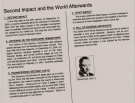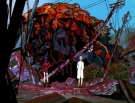Neon Genesis Evangelion: Difference between revisions
(WHAT A DISASTER. Maintenance templates x3) |
(→Problems That Affected of Quality and Outcome of Evangelion: Pictures of the recycled shots would be helpful, unless there's already an article all about it.) |
||
| Line 12: | Line 12: | ||
Evangelion was written and directed by [[Hideaki Anno]], with Character Design by [[Yoshiyuki Sadamoto]], and Mechanical Design by Anno and Ikuto Yamashita. Space precludes our listing all of the co-writers and co-directors who worked on the individual episodes. Besides, Evangelion is Anno's baby; he is ultimately responsible for the course and outcome of the show. The music was composed by [[Shiro Sagisu]]. | Evangelion was written and directed by [[Hideaki Anno]], with Character Design by [[Yoshiyuki Sadamoto]], and Mechanical Design by Anno and Ikuto Yamashita. Space precludes our listing all of the co-writers and co-directors who worked on the individual episodes. Besides, Evangelion is Anno's baby; he is ultimately responsible for the course and outcome of the show. The music was composed by [[Shiro Sagisu]]. | ||
== | ==Animation Degradation== | ||
Evangelion suffers from a noticeable gradual decrease in animation quality, to the point of infamy. As production of the series progressed, more and more of the long term budget disappeared causing a number of animation tricks to be implemented in order to cut corners. These included: recycled shots ("Bridge Bunny" reactions, console screen close-ups), long distance shots, covering lip flaps with hands or clipboards, and 1 minute shots of static images. By the end of the series, whether it be out of desperation or artistic license, [[Episode_25|episodes 25]] and [[Episode_26|26]] become minimalist and introspective look at the characters with little to no direct continuation of the external action orientated story. The release of [[The End of Evangelion]] provided an alternative, animation heavy ending. | |||
==Note on the name '''Neon Genesis Evangelion'''== | ==Note on the name '''Neon Genesis Evangelion'''== | ||
Revision as of 23:20, 9 March 2011

|
"The story presented to the public was just a cover-up." |

|
"Making something... Nurturing something is really great. You can see and learn so many things from the process." |

|
"When Aoba called B Wing's construction sloppy he hadn't seen anything like THIS!" |
General Information
Neon Genesis Evangelion is a 26 episode anime that ran on Japanese television from Dec. 4, 1995 to March 27, 1996. It involves a 14 year old boy, Shinji Ikari, summoned by his long-absent father, Gendo Ikari, to pilot a bio-mechanical being known as an Evangelion or Eva. His task is to battle mysterious beings known as Angels, who are somehow known to be due to begin their attacks soon. But behind-the-scenes events may, in the long run, affect his fate, and the fate of the world, more than the fight against the Angels.
Subsequent to the end of the television series, there were two Evangelion movies: Neon Genesis Evangelion: Death & Rebirth, and Neon Genesis Evangelion: The End of Evangelion. Death and Rebirth starts as a compilation of footage from the series, (not a condensation, but instead categorized by the character). The remainder is part of the first half of End of Evangelion. Originally, they were to be one long movie, but deadline problems forced them into releasing it as two movies. The most recent Japanese video release of the first movie includes only the compilation footage, "Death", as all of Rebirth is included in The End of Evangelion. The End of Evangelion is a retelling of and an expansion upon the events in the last two episodes of the TV series. EOE clarifies the meaning of the abstract ending seen on TV, (see below), without changing it significantly. Note: As you can see, that statement has a link. This is because this is still controversial in certain quarters. It is the belief of nearly every member here that the endings are concurrent, but follow the link to see the arguments on both sides. (When we get that section up.)
Creators
Evangelion was written and directed by Hideaki Anno, with Character Design by Yoshiyuki Sadamoto, and Mechanical Design by Anno and Ikuto Yamashita. Space precludes our listing all of the co-writers and co-directors who worked on the individual episodes. Besides, Evangelion is Anno's baby; he is ultimately responsible for the course and outcome of the show. The music was composed by Shiro Sagisu.
Animation Degradation
Evangelion suffers from a noticeable gradual decrease in animation quality, to the point of infamy. As production of the series progressed, more and more of the long term budget disappeared causing a number of animation tricks to be implemented in order to cut corners. These included: recycled shots ("Bridge Bunny" reactions, console screen close-ups), long distance shots, covering lip flaps with hands or clipboards, and 1 minute shots of static images. By the end of the series, whether it be out of desperation or artistic license, episodes 25 and 26 become minimalist and introspective look at the characters with little to no direct continuation of the external action orientated story. The release of The End of Evangelion provided an alternative, animation heavy ending.
Note on the name Neon Genesis Evangelion
The actual Japanese title is Shin Seiki Evangelion, a hybrid Japanese-Greek title which means "Gospel of the New Century". The title Neon Genesis Evangelion is all Greek, and means "Gospel of the New Genesis". However, this is not a case of the English-language distributors messing with the translation. Neon Genesis Evangelion is the official English title, chosen by the series' Japanese creators.
